2012 Yamaha FX Nytro RTX Review
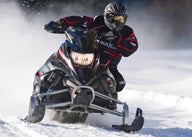
The backbone of Yamaha's cross-country racing effort
Who would have thought that after all the effort Yamaha put into establishing its 4-stroke advantages of engine reliability and overall durability, the company’s 4-strokers would leave potential buyers with performance anxiety? How does that happen to an engineering-driven company like Yamaha, which produces world-renowned and championship motocross and asphalt racing bikes as well as highly regarded automotive engines? If you know the answer, Yamaha would like you to share it.
Engine Type:Horizontal In-line
Cylinders:3
Engine Stroke:4-Stroke
Valve Configuration:DOHC
Displacement:1049 / 64
Starter:Electric
Turbocharged:No
View Full SpecSeems that in its efforts to convince the snow world that its all-4-stroke line of snowmobiles are incredibly durable, the marketers forgot to remind people of its performance heritage. Hey, let’s not forget where the Apex four-cylinder motor came from. Anyone recall Yamaha’s R1 super street bike? That fits into the category of super fast and is the basis for the free revving Apex quad.
The Phazer’s 500cc twin draws its heritage from Yamaha’s dirt-conquering performance 125 and 450 off-road screamers. The broad torque of the Yamaha triples comes in a linear fashion that makes getting off the mark and coming off turns as familiar as rolling on the throttle of your street cruiser.
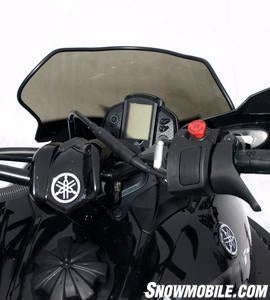 The RTX gauge sits tall to be read while hammering a ditch line or cruising a groomed trail.
The RTX gauge sits tall to be read while hammering a ditch line or cruising a groomed trail.
With all that in mind, you’ll appreciate the Yamaha dilemma of a public perception that views the Yamaha powerplants as stone reliable but maybe at the expense of performance. Have you ridden a new Apex lately? It may be extremely easy to drive on any trail thanks to the electric power steering and EXUP exhaust tuning, but seeing 10,000-plus revs on the RPM counter is pretty extraordinary for any power toy, much less an extremely reliable 4-stroke snowmobile! How can that not be performance?
When it comes to performance and reliability, there are certain things you need to understand about Yamaha snowmobile engineering. This is an engineering, if not engine, driven company. There is a great deal of pride that is engineered into every cubic centimeter of displacement in any Yamaha motor, whether it’s a 50cc scooter engine or a high-performance super bike engine. But, for Yamaha, getting performance is relatively easy. Getting high performance that lives mile after wide open throttle mile is a bigger challenge and one that Yamaha takes more seriously than most other engine builders. Over the years, we have sometimes thought that Yamaha may be too cautious in its engineering as it tends to rarely, if ever, release a product without more testing than any one of us could ever imagine. But, that is exactly why people buy Yamaha. They believe in the quality. And the performance.
Right now Yamaha snowmobile marketers are trying to get more sport sled buyers to look at its Nytro models as being the performance alternative to the Ski-Doo MXZ, Polaris Rush and Arctic Cat models. To get people’s attention, you’ll see a small, but very serious contingent of Yamaha Nytro snowmobiles being raced in cross-country events from Maine to Minnesota.
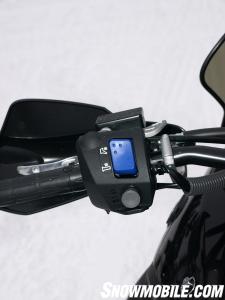 With handlebar hooks, the Yamaha offers rider-friendly controls.
With handlebar hooks, the Yamaha offers rider-friendly controls.
Yamaha is back in racing and the weapon of choice is the Nytro RTX, a 130-ish horsepower triple that will do battle with some established terrain sleds like the Ski-Doo and Arctic Cat Sno Pro 600. We’re not going to say that we expect to see the Nytro rocking to victory after victory, but we expect Yamaha to be more competitive in terrain racing than in snocross, which it abandoned almost two seasons ago.
The Nytro RTX should be well suited to the task of terrain performance. It comes from a snocross background, which means it derived its racer-forward riding position from that series as well as its basic front and rear suspensions. The sled should prove much more adept in cross country racing where racers have to go fast for miles over a variety of terrain that can vary from ice-covered lakes to concrete-hard snow-filled ditches to wide-open county roads. We would expect the 1049cc Yamaha 4-stroke triple to be an asset as it delivers extremely strong torque and good top end. And, of course, this is where that durable and reliable thing will work for you!
The 2012 Nytro RTX makes a great base for this latest Yamaha effort. The powerplant is proven. With its 41mm Mikuni electronic fuel injection system feeding the three cylinders according to throttle opening, atmospheric needs relative to barometer and temperature, the 12-valved engine should make the racers competitive.
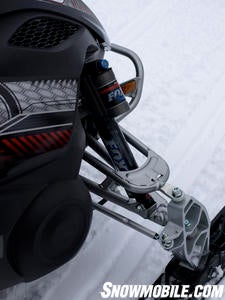 Double wishbones and the latest Fox Float X dual-clicker shocks make the RTX a true trail performer.
Double wishbones and the latest Fox Float X dual-clicker shocks make the RTX a true trail performer.
The snocross-derived platform will provide good balance and its FXG2 next iteration of Yamaha’s double wishbone front suspension will offer up to 8.5-inches of travel. Control of the front end comes from the latest Fox Float X dual-clicker shocks. Racers and performance riders can fine-tune these shocks to deliver exactly the necessary ride enhancements needed for any terrain. Yamaha mounts the shocks to allow the shock rod to give maximum unrestricted travel action, which will work well in the nastiest stretches of stutter bumps.
The Dual Shock Pro 46 rear suspension suits racers and sport riders equally well. The basics are: 14.5-inches of travel controlled by a high-pressure gas C40 R16 dual-clicker with a C46 R16 three-clicker shock on the rear arm. This allows riders to adjust both high speed and low speed compression damping. Since the rebound rate is also fully adjustable the rider can precisely fine-tune his ride.
Yamaha offers a very “trick” set up for its competition-oriented riding public. And, of course, it’s proven reliable. That’s a very good thing.
With power and ride designed for serious performance enthusiasts, the Nytro RTX enters 2012 enhanced for glitch-free performance. There are freer moving single-piece extrovert drive sprockets; a lightweight rear-exiting exhaust (a Yamaha exclusive!); easy maintenance replaceable bearings on the support wheels; and over-engine steering to get the rider positioned for rough trails.
The 2012 Nytro RTX is Yamaha’s top trail performance model but still incorporates plenty of nice to have features like electric start, reverse, an informative digital read out gauge, plus hooked handlebar ends and a seat that gives you ample comfort while providing a sculpted style to give hard chargers room to move quickly.
The 2012 Yamaha Nytro RTX will be seen in terrain events this season in hopes that more riders will think of Yamaha as a durable high-performance sled that can run with and beat the competition.
From our standpoint, we can only envision that lessons learned in terrain racing will serve to improve future Yamaha sport sleds. After all, almost all of us ride in the real world, not the TV-world of snocross.
| 2012 Yamaha Nytro RTX Specs | |
| Engine | Yamaha Genesis 130FI; liquid-cooled, 1049cc 4-stroke triple; bore x stroke, 82.mm x 66.2mm; Mikuni 41mm fuel injection |
| Horsepower | 130 |
| Drive | Yamaha YVXC variable ratio drive and driven |
| Front Suspension | Yamaha double wishbone FXG2; 8.5-inches maximum travel; Fox Float X dual-clicker high-pressure gas shocks |
| Rear Suspension | Yamaha Dual Shock Pro 46; 14.5-inches maximum travel; C40 R16 aluminum gas shocks on front arm with C46 R16 3-way clicker on rear suspension arm |
| Brake | Yamaha 4-piston hydraulic with lightweight disc |
| Length | 110.4 in |
| Height | 44.8 in |
| Ski Stance | 41.3 in |
| Track | 15 x 121 x 1.25 Camoplast RipSaw II |
| Weight | NA (522 lbs 2009 FX Nytro) |
| Fuel Capacity | 7.4 Gal |
| MSRP | US$12,199 |
Related Reading
2012 Yamaha RS Vector EPS Review [Video]
2012 Yamaha RS Venture GT Review
2011 Yamaha FX Nytro Review
2011 Yamaha FX Nytro XTX Review



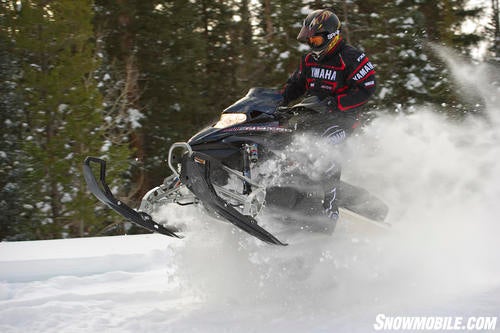
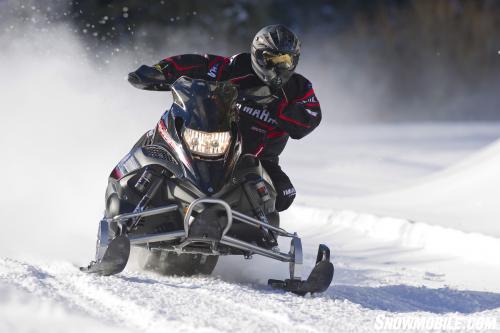





 Your Privacy Choices
Your Privacy Choices